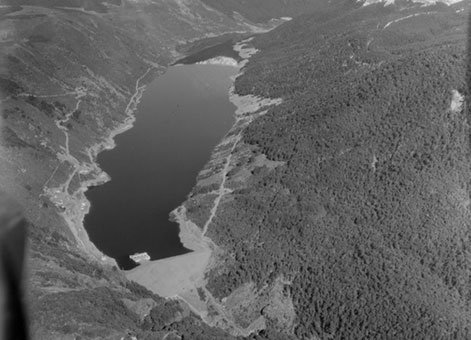The Cobb Dam, built between 1936 and 1956, has a special place in the history of New Zealand dams. It was the first to incorporate instruments for the measurement of internal water pressures. It was also the first hydro-electricity dam to be built using modern soil control methods.

Hydro Power Station, at Cobb River, Kahurangi National Park, Nelson [September 1958]. Ref; WA-47448-F, Alexander Turnbull Library, Wellington, New Zealand.
Early investigations for the Cobb Dam revealed that what looked like outcrops of rock in the valley floor were in fact huge boulders suspended in moraine. The site was consequently unsuitable for a concrete dam.
The dam site is 784 metres (m) and the lake 808m above sea level making this hydro water storage the highest in New Zealand. The Cobb Power Station, supplied by the dam, could generate with a gross head of 593 m. So valuable is the water, every possible means was used to store it during the construction of the Cobb Dam including the raising of the small natural lakes in the catchment and the building of a temporary dam upstream.
The dam is comprised of a silty gravel core with sandy gravel shoulders with a height over foundation of 35 m and a crest length of 214 m. The spillways and sluices are combined in a concrete structure built into the earth dam to the right of centre line. The dam took more than four years to build. The spillway has a capacity of 857 cubic metres per second.
The climate at the site was adverse for construction. The annual rainfall is over 2,200 millimetres (mm) and over 400mm has fallen in 6 hours. There were frequent large floods. In winter snow, heavy frosts and rain restricted construction.
The dam provides water to the power station via two 4 kilometre (km) long steel penstocks. The powerhouse has four 3 megawatt (MW) and two 10 MW Pelton turbines, which generate a maximum output of 32 MW. Because of the high head, this comes from a flow of 7.25 cubic metres per second.
Construction professionals
Design: Hydro Design Office, Ministry of Works
Construction: Ministry of Works.
Find out more
Access
Cobb Dam Road is inland from Motueka in the Kahurangi National Park and starts from State Highway 60 at Upper Takaka. After passing the Cobb Power Station it climbs steeply to the crest of the range before descending into the upper Cobb Valley (18 kilometres). The road passes over the dam.
Further reading
AK Blair, The Cobb – The History of Cobb River Hydro-electric Power Scheme, 1994.
